Surgical Concept
Breast surgery is the most diverse and challenging surgical procedure in the field of cosmetic surgery. This is because surgeons need to satisfy the subjective requirements of patients in varying conditions and do so in a manner that maintains and accommodates the health and functions of the breasts. Moreover, during surgery, plastic surgeons need to overcome the constraint and barriers caused by skeletal structures and the elasticity of the skin to precisely create an esthetically proportionate breast curvature. In addition, they must assist patients in preserving the surgical results until there is complete fixation. Thus, breast surgery amounts to the most arduous and taxing operation among all cosmetic surgeries. Nevertheless, this work, which integrates beauty with creation, deeply intrigues Dr. Chuang, who has been dedicated to this research for several years. The Japanese breast augmentation expert Dr. Yoshinori Nagumo specifically instructed Dr. Chuang and has highly commended his work.
Dr. Chuang believes that breast surgery is an art of “roundness” and “contour.” The ability to create balanced, symmetrical breast shapes among different physiques, while simultaneously accommodating breast texture and softness, is often the most difficult part of breast surgery. Highlighting breast curvature without compromising beauty requires not only rich experience and proper judgment by the surgeon but also esthetic cultivation to achieve success. Since his childhood, Dr. Chuang has learned art, which has helped him cultivate a sense of art appreciation. He is not only merely adept at sketching and drawing but also has a keen insight of human anatomical structures and body curvatures.
When performing a breast augmentation surgery, Dr. Chuang pays particular attention to the proportion between the breast and thorax. He emphasizes that the dimension of breast prosthetics should be determined from the breast concentration and shape, which is determined by the nipple position, before the height is factored in to determine its size. Keeping these principles in mind can help in accurately determining the size of breast prosthetics suitable for patients as well as in customizing adjustments and providing recommendations to patients who have varied requirements. Having full and beautiful breasts is no longer a dream; rather, it has become an obtainable reality.
Perfect breast shape schematics
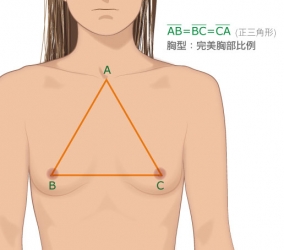
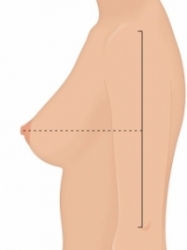
Besides detailed and logical preoperative evaluations, surgeons also need to have the capability to perform surgery with precision to fulfil patients’ requirements. Therefore, Dr. Chuang has spared no expense in purchasing high-resolution endoscope devices equal to those used by first-class teaching hospitals to offer his patients thorough and comprehensive breast augmentation surgeries. These endoscopes help to look inside the human body and provide a clear image of the breast’s internal tissue and structures during surgery. This not only avoids undesired nerve or blood vessel injuries, which can minimize postoperative pain and swelling, but also allows for the real-time management of any potential intraoperative accident to provide for the maximal prevention of surgical complications and risks, thus directly increasing surgical safety. In addition, Dr. Chuang uses various types of breast prosthetic sizers during surgery to confirm whether the preoperative evaluation is in accordance with expected surgical results. He upholds that more conscientious confirmations during surgery will further guarantee positive postoperative results. Such objective scientific measures coupled with an abundant surgical experience can remarkably elevate the positive result rate and consistency of breast augmentation.
Patients’ requirements and expectations from breast surgery are progressively increasing. Their desire is not to simply have two mounds of flesh that can only be appreciated from a distance but to have an “uncannily lifelike” effect. To achieve optimal breast augmentation results, apart from surgery, regular postoperative breast massage is essential. Dr., Chuang knows well that postoperative follow-up and care is the most important part of ensuring breast augmentation results. Therefore, in addition to frequent and long-term postoperative follow-up visits and re-examinations, Wish clinic offers professional breast care courses. This two-dimensional approach of routine postoperative follow-up along with daily proper self-massage may help prevent the development of capsules and enable sculpted breasts to feel soft and natural like real breast tissue.
Finally, Dr. Chuang wants to stress that breast health should always come before beautiful appearance. Along with successful breast augmentation, it is important to ensure proper breast examination. Therefore, Wish Clinic has pioneered a program that provides breast prosthetics with a 10-year warranty, which is in line with international practice, as well as offers breast prosthetic ultrasound imaging once a year to patients with silicone implants or helps patients arrange out-of-pocket breast MRI studies. In this way, through close cooperation between physicians and patients, you may benefit from both successful results and breast care provided by our professional team in order to have both health and beauty.
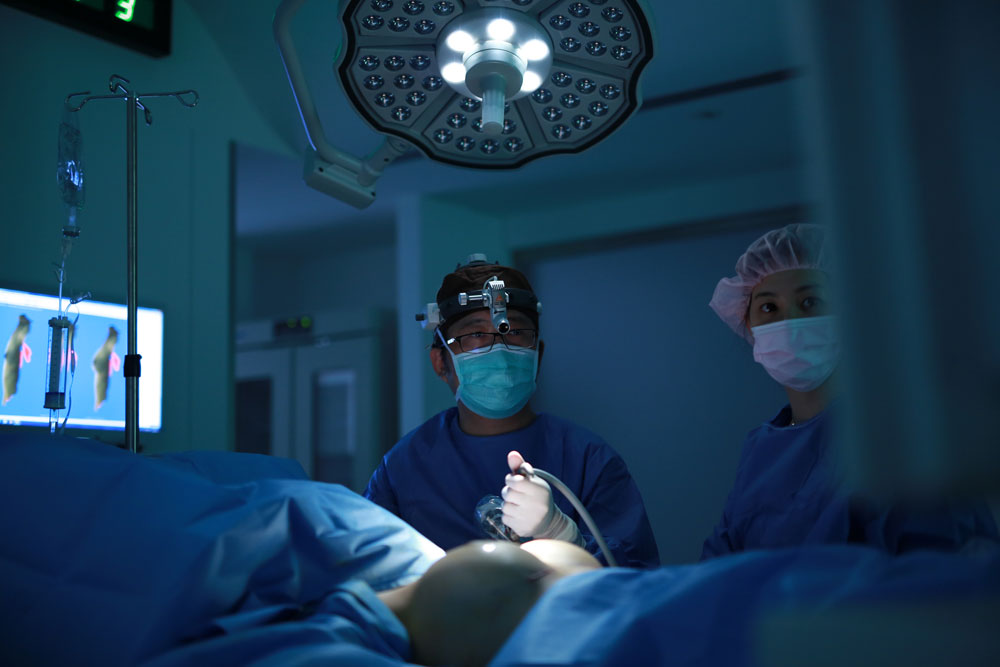
We combine the most advanced preoperative 3D image simulation and endoscopic breast augmentation surgery in order to create the most perfect outcome.
Surgical Characteristics
Preoperative 3D imaging simulation
Good preoperative communication plays a very important role in achieving successful surgical results. This is particularly true in the case of establishing breast size and shape according to patients’ expectations. In addition to professional suggestions made by the physician, seeing an image simulation will increase patients’ knowledge and confidence about the surgery and enable them to have concrete and reasonable expectations regarding postoperative effects. This signals the future trend of utilizing cosmetic technologies. Therefore, our hospital has invested in the Axisthree 3D simulation system, which is the most advanced imaging simulation system in the world, to provide patients undergoing breast augmentation with the most objective and scientific preoperative evaluation available. This will effectively narrow the communication and cognition gap between physicians and patients, and in combination with the abundant experience of Dr. Chuang in performing breast surgery and his esthetic sense, will improve the simulation precision rate to >85%.
The Axisthree 3D simulation system utilizes the color-coded triangulation technique jointly developed with Siemens. Four-position imaging can rapidly process an image and accurately calculate the volume and capacity as well as allow an unobstructed view of the axillary or submammary blind angles. Moreover, it can estimate the parameters of skin elasticity and display these values on a computer. Based on these values, Dr. Chuang selects the appropriate type and size of breast prosthetics in coordination with computer parameters to present a complete customized preoperative image simulation. In this way, patients can fully preoperatively visualize the breast shape and size and have the opportunity to communicate further with Dr. Chuang about their expectations depending on simulated images. This exercise can greatly reduce the gap between preoperative expectations and actual postoperative results and also gives patients the opportunity to participate in the preoperative evaluation and have more confidence in the surgery.
We provide the most sophisticated and professional preoperative 3D imaging simulation system in the world. A 30-min exercise is all that is required to learn more about surgical results prior to the surgery.
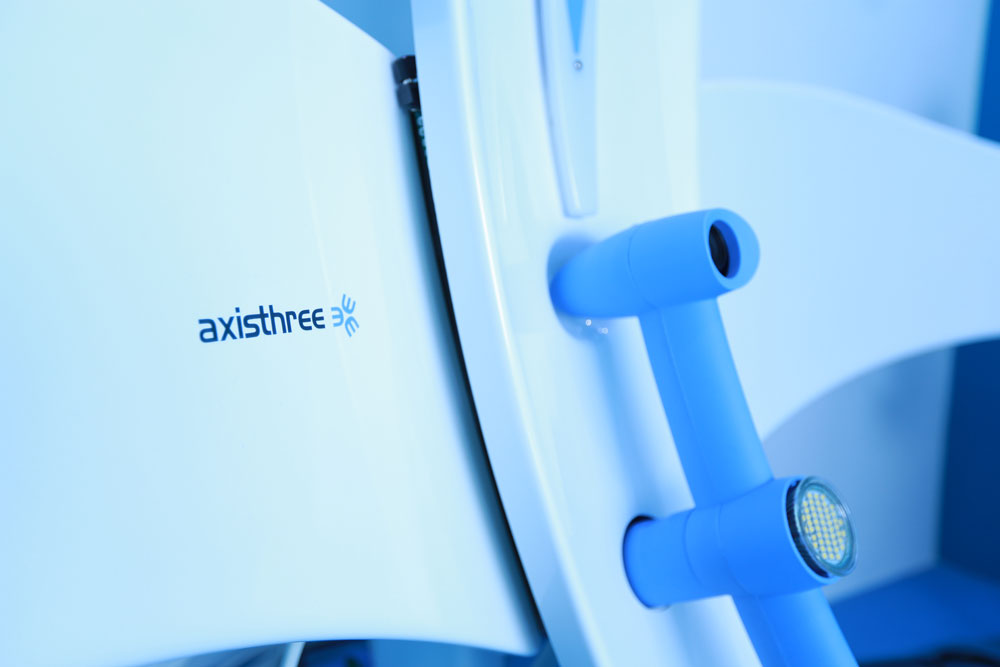
The 3D image simulation analysis enables patients to foresee surgery results.
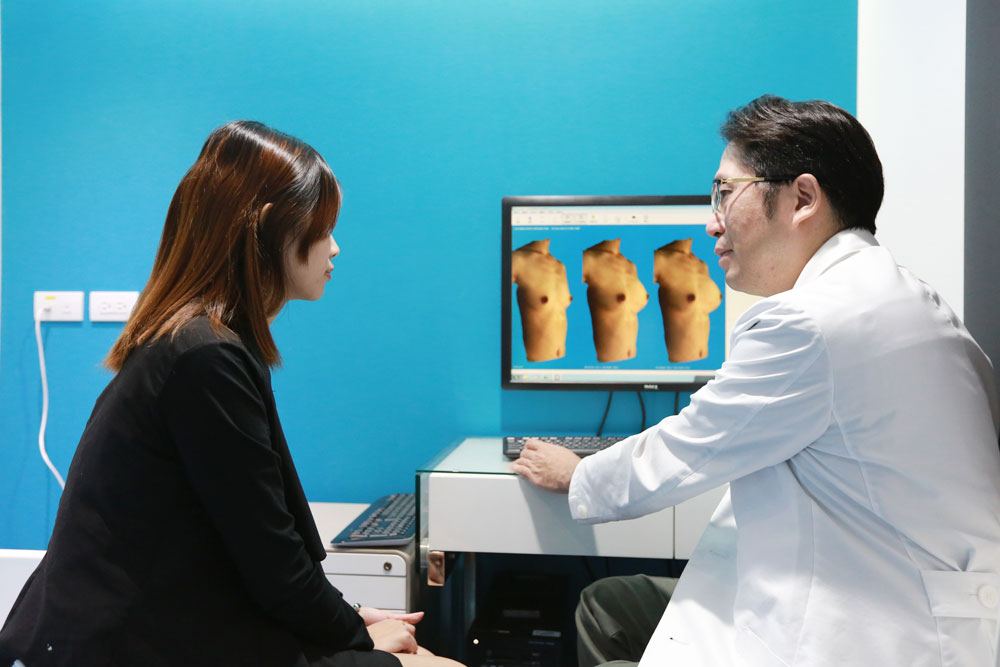
With the most advanced preoperative 3D image simulation, the surgeon is able to grasp the patient’s most desired outcome.
High-resolution endoscopic breast augmentation
Presently, endoscopic breast augmentation is the most advanced and safest method of surgery. A tubular microscope is inserted into the surgical space, which then magnifies the images of internal structures and transmits them to a screen that a surgeon can view. This allows the surgeon to dissect tissues with electrocauterization to avoid unwanted ruptures or injuries as well as ensure the safety and stability of the surgery. Currently, Dr. Chuang incorporates endoscopy into the procedure of breast augmentation surgeries. This surgical approach has the following advantages compared with traditional blind dissection:
- Less intraoperative hemorrhage (only 50 cc on average)
- Possibly less damage to nerves and reduced sequelae related to compromised postoperative sensitivity
- Complete intraoperative hemostasis and less prone to cause acute hemorrhage or hematoma and other complications
- Concurrent real-time imaging and surgery to ensure complete dissection
- Instant contracture of tissues after cauterization with an electrocautery knife to markedly relieve postoperative pain
- Able to perform advanced sub-fascial breast augmentation requiring delicate dissection
Nevertheless, endoscopic surgeries may also have the following drawbacks:
- Surgical procedures are complex and time consuming
- Dissection is complete, which may cause the skin to loosen
- Cauterization may result in long-term breast effusions or edema
Wish clinic is equipped with a top US Stryker 1288 high-resolution endoscope, which is an advanced system used in teaching hospitals. Its probe not only visualizes the course of each capillary or nerve in the human body but also adjusts background light to view different anatomical structures and distinguish each layer of muscle and tissue in an effort to avoid unnecessary tissue injuries. This significantly elevates the safety and stability of breast augmentation and enables Dr. Chuang to fully exercise his expertise to achieve desired surgical results, which helps earn the satisfaction of and recognition from more patients.
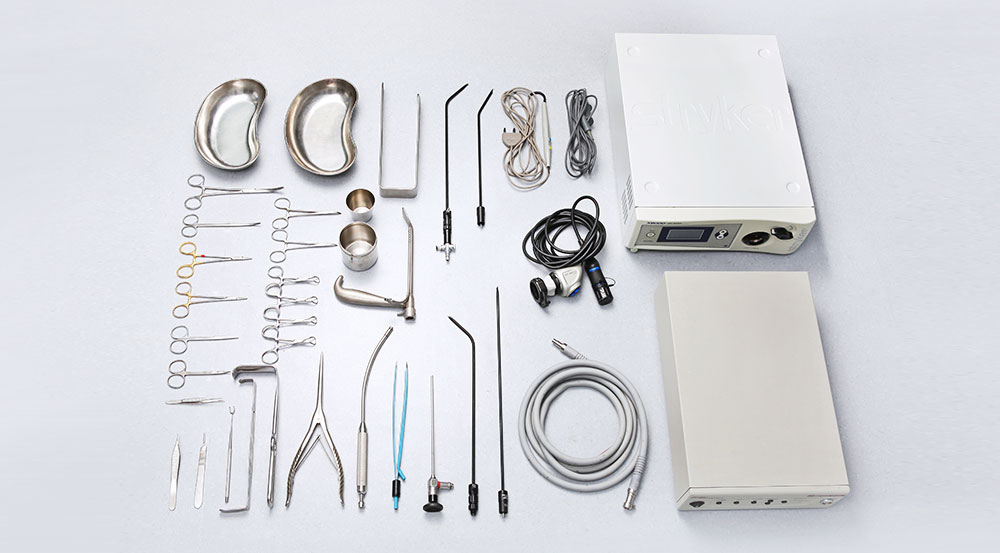
Various complicated and intricate surgical equipments are the basic tools to a successful breast surgery.
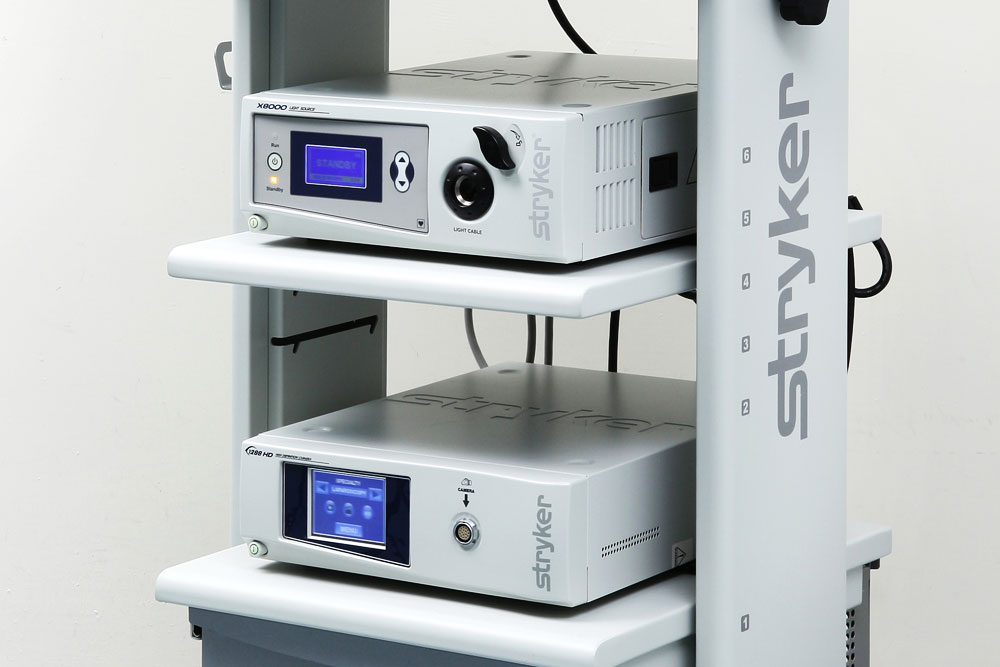
High-end endoscopic facility provides a clear operative view for the surgeon which is the foundation to a successful procedure.
Diverse breast prosthetics
Dozens or even hundreds of combinations of different types and sizes of breast prosthetics are available. This makes the selection of breast prosthetics complex, where an accurate determination often relies on the experience of the surgeon. Particularly, for oriental women with thin figures, breast texture and appearance are equally important. Therefore, selecting the appropriate type and material of breast prosthetics, according to the figure of each patient, is critical for the creation of natural and realistic breasts.
Based on the content material, current breast prosthetics mainly comprise saline and silicone implants, with an option for a smooth or textured (rough) surface for the outer envelope. All smooth implants are available in only a spherical shape, whereas textured implants are available in spherical or teardrop-like shapes (anatomic implants). Smooth implants can yield a relatively soft and natural texture with a less visible spherical sense. However, postoperative breast massage is necessary, and smooth implants may cause temporary pain and result in prolonged care. They best suit skinny patients or those pursuing a natural look and sense of touch. Textured implants do not require breast massage, cause very little pain, and stabilize very quickly. However, they may show a higher projection, like a ball, especially when lying down. Therefore, they are indicated for plump patients or for those who cannot go through postoperative massage. Saline or silicone implants are used depending on individual skin conditions and subjective acceptance and the discretion of patients.
The advantages and drawbacks of implants are as follows:
| Saline implants | Silicone implants | |
|---|---|---|
| Content | The outer envelope is made of soft silicone rubber. The implant is first curled over to drain the interior air and is then filled with the required volume of normal saline after being placed in the body. Then, the feeding tube is removed, and the valve is sealed to prevent leakage. | The outer envelope and filler are both made of silicone so that the interior and exterior share a consistent density. In addition, there is no injection valve at the implant surface; thus, the entire prosthetic breast needs to be placed. Furthermore, there is no need for water infusion or tube removal. |
| Advantages | Physically less invasive (approximately 2 cm), low cost, and no damage to the human body even in the case of leakage. Therefore, it does not need long-term postoperative follow-up. | It offers a relatively realistic and natural texture because its density is similar to that of human tissue. There is no natural leakage as in the case of saline implants because of the cohesive silicone gel filler. Thus, the breast dimension and size can be maintained for a long time. Even if there is outer envelope rupture, the silicone gel will not flow outside. The US Food and Drug Administration has validated the safety of silicone implants. Therefore, there is no concern about the duration of use if regular follow-up is ensured. No breast cancer or malignancy has been proved to be related with this implant. |
| Drawbacks | Its use lasts for approximately 10–12 years. Thereafter, there may be valve aging or shrinkage from natural fading, and implant edges or wrinkles are likely to be felt. The texture is relatively not natural as that of a real breast. | It requires a relatively long incision (approximately 3.5–4 cm), and the cost is high. In addition, a regular out-of-pocket magnetic resonance imaging (MRI) should be postoperatively performed every 2–3 years, as recommended by the Ministry of Health and Welfare of Taiwan, in an effort to monitor the safety of prosthetic breasts. If a ruptured implant is left inside the human body for a long period of time, it may result in a regional inflammatory reaction or hard lumps in the breast. |
Wish clinic offers various types of silicone gel and saline implants that have been approved by the government for legal use. Dr. Chuang will also provide professional recommendations depending on the figure of each patient.
Wish clinic uses legally imported breast implants from the following companies:
Motiva: https://motiva.health/
Sebbin: https://www.sebbin.com/en/category/mammary-implants/
Mentor implant: http://www.mentorwwllc.com/global-us/Breast.aspx
Natrelle breast implant: http://www.natrelle.com/
Gcaesthetics breast implant: https://www.gcaesthetics.com/
POLYTECH Health & Aesthetics GmbH: https://polytech-health-aesthetics.com/de/
Numerous options for surgical incisions
A surgical incision is necessary to place breast implants; however, it bears no correlation with final surgical results. Any incision will allow the placement of various implant types and tissue dissection; thus, there is no specific incision site used. However, the selection of the incision method should take into account patients’ subjective requirements and objective conditions. Before surgery, it should be carefully considered how the incision will postoperatively affect patients’ activities. Some considerations include what method will best conceal the incision scars or how the incision will correlate with patients’ work, clothing, and physical exercise regimen in an effort to avoid unnecessary disturbance and restraint consequent to the scars. Currently, we offer the following incision methods to patients undergoing breast augmentation:
| Transaxillary incision | Periareolar incision | Inframammary incision | Transumbilical incision | |
|---|---|---|---|---|
| Method | Transaxillary incision is most common among local patients, accounting for approximately 70% of all breast augmentation surgeries; it is particularly common among single women. A surgical incision is made at the deepest or longest axillary skin fold and necessitates damage to a part of the lymphatic and vascular tissues when entering the breast for surgery. The incision length, which is an average of 2–4 cm, depends on the saline or silicone implant used. The scar is embedded in skin wrinkles or hair and is not visible. | Periareolar incision is the second most common incision method and accounts for approximately 20% of all breast augmentation surgeries. An incision is made between the inferior half of the areola’s circumference and the adjacent normal skin; posterior mammary tissues are partially dissected to create space for breast augmentation. The incision length is approximately 2.5–3 cm, regardless of whether silicone or saline implants are used. This method is not indicated for patients with congenitally small areolae (diameter smaller than 2 cm). | An inframammary incision is made in the shadow area along the inframammary border and accounts for 8%–10% of all breast augmentation surgeries. It is mainly indicated for secondary operations or teardrop implant placement. Affording the closest access to breast tissues, an inframammary incision does not damage the lymphatic or mammary tissues and is the safest and fastest method of breast augmentation. The incision length is approximately 4–5 cm, depending on the type and size of breast prosthetics to be placed. | A transumbilical incision is made at the superior margin of the navel and tunnels superior to the breast via a particular subcutaneous channel. It is the most distal breast augmentation method and is also called “invisible breast augmentation” because no incision is made in the breast. However, this incision is appropriate only for saline implants. Because silicone implants are now the common choice, this method has been gradually abandoned. |
| Advantages | Surgical scars are embedded in the hollow area of the armpit, keeping the skin on the chest intact and flawless. | There is no pain sensation after surgery, no restrictions on arm movement, less scar adhesions, and an all-round surgical field (360°), which allows for the better management of any complex problems. | It is the least invasive method and shows fast recovery. Scars are hidden in the inframammary shadow so are less visible. There is no pain sensation after surgery or scar adhesion. | The chest skin is intact and free of scars. Umbilical incisions are less likely to be associated with breast augmentation. |
| Drawbacks | Patients need to perform frequent, and possibly painful, rehabilitation exercises such as raising their hands and stretching their muscles. Moreover, it may result in scar adhesions that can limit arm movement, cause breast deformity, or negatively impact axillary sweating or odor. | Scars are visible on the areolae and may not fade, the nipple may become less sensitive, and mammary obstruction or inflammation could develop. | The incision might be long, and scars are visible when lying down. | It is indicated only for saline implant placement. There is obvious pain after the surgery, and surgical results are inconsistent. |
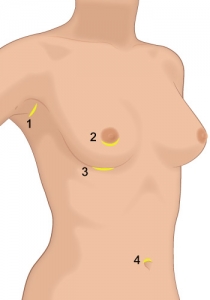
Schematics of surgical incision:
- Transaxillary incision
- Periareolar incision
- Inframammary incision
- Transumbilical incision
Individualized prosthetic implantation site
The site and approach of placing a breast implant may affect the appearance and texture of the breasts. In addition, extensive applications of endoscopic breast augmentation surgeries and various uses of silicone implants make the site of placing breast implants more diverse. Previously, conventional subpectoral (submuscular) placement was widely used for saline implants, but it has been gradually replaced by the less painful and easy-to-care subfascial or dual-plane placement method. However, because the appropriate site for breast implant placement varies for each individual and accommodations must be made for natural appearance and soft texture, patients’ skin conditions and required size should be taken into consideration for the final decision. Dr. Chuang has abundant experience and expertise in endoscopic surgery and offers various breast implant placement approaches to meet the needs of his patients.
| Subpectoral placement | Subfascial placement | Dual-plane placement | Composite placement |
|---|---|---|---|
| This is the most frequently used approach. Implants are placed beneath the pectoralis major muscle at the deepest level of the breast to achieve maximal coverage and improve the texture and naturalness of the implants. It is mainly used by patients with thin skin or insufficient soft tissue coverage and is appropriate for either silicone or saline implants. It allows the deep placement of breast implants and provides a natural feel and texture. However, it may cause pain on postoperative massage and results in prolonged care. In addition, arm use or movement may be temporarily limited to avoid compromising surgical results. | A breast implant is placed between the pectoralis major muscle and the mammary gland. It is a relatively advanced breast augmentation method and is generally indicated only in case of silicone implants because saline implants are more likely to be noticeable or there may be palpable wrinkles. The advantages are that breast implants are not subject to motion or compression by the pectoralis muscle. There is no pain with postoperative massage; there is rapid breast stabilization as well as shorter care and less chance of limited arm movement. Its drawbacks are that it is inappropriate for saline implants or for patients with excessively thin skin on account of an increased risk for an unnatural appearance or sense of touch. | Also called “partial subfascial, partial submuscular” breast augmentation, it is a relatively new endoscopic breast augmentation approach. A breast implant is placed beneath the fascia but with partial dissection of the muscular tissue at the midline or lower half of the breast to increase the coverage of implants in terms of thickness and area. This method is suitable for patients with insufficient skin conditions who desire to opt for subfascial breast augmentation. It can provide the naturalness of subpectoral placement and the painlessness and convenient care of subfascial surgeries. However, the procedure is relatively complicated, and it is appropriate only for silicone implant placement. | This is a method that integrates breast implant placement and autologous fat grafting in one surgery. It is applicable for patients with extremely poor conditions for breast augmentation or those requiring special breast correction or reconstruction. Rough-surface (textured) breast implants are primarily used. Its advantage is that fat grafting can offset the thinness of the skin and improve the texture and naturalness. Its drawbacks are autologous absorption of the fat and uncertain final results. |
The above surgical approaches may appear diverse and complex, but patients’ conditions for breast augmentation and the selection of breast implants must be carefully evaluated. Dr. Chuang allocates sufficient time to understand the requirements of each patient during the preoperative consultation, before making suggestions for the appropriate breast augmentation approach.
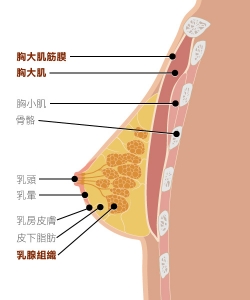
Relevant position of the mammary gland, fascia, and pectoralis major muscle.
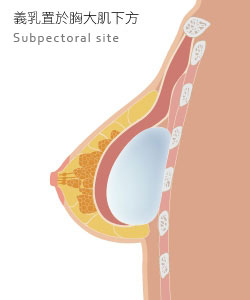
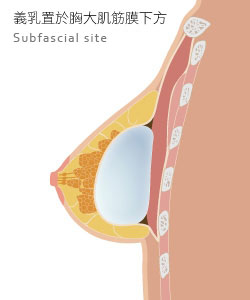
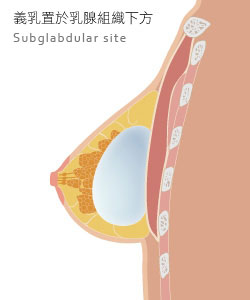
Common site for breast prosthesis placement.
Advanced anesthesia method and option
Safe anesthesia is our greatest concern during plastic surgeries. Wish clinic not only possesses the most advanced anesthesia and emergency equipment but also has professional anesthesiologists to monitor and care for patients during the entire course to provide the highest guarantee of anesthesia-related safety. To complement the diverse approaches of breast augmentation surgeries by Dr. Chuang, we provide patients with the following options for anesthesia:
| General anesthesia | High-level epidural anesthesia | Target-controlled infusion (TCI) | |
|---|---|---|---|
| Method | This is the routine anesthesia method for breast augmentation surgery. It utilizes an automatic monitoring anesthetic machine in combination with inhaled anesthetics to render patients completely free of pain and memory. It is indicated for long-term surgeries such as endoscopic breast augmentation or reduction mammoplasty. | This is the same as epidural anesthesia used for painless labor. An anesthesiologist inserts a thin catheter into the paravertebral subdural cavity and slowly injects local anesthetics into the cavity, which may reduce perithoracic sensation in approximately 15–20 min. In addition, a low dose of intravenous anesthetics (IV sedation) may be used during surgery so that patients can undergo the surgery without any pain. | This is a safe and convenient intravenous anesthesia method (IV sedation). A fixed dosage of anesthetics is infused into the blood stream at regular intervals as the microcomputer of a TCI infusion pump accurately calculates the weight and dose needed to sustain a constant optimal concentration of anesthetics. Thereby, the surgery is performed without pain or memory. |
| Advantages | General anesthesia results in a total loss of sensation, and combined with muscle relaxants, it enables surgeons to conduct complete dissection during surgery and to adjust for optimal breast form and proportion. | This is highly safe regional block anesthesia. The anesthetic area may be controlled at the thorax and upper limbs. Patients do not need intubation or the use of inhaled anesthetics, thus avoiding the discomfort and risk of general anesthesia and enabling patients to rapidly recover and walk within an hour. Moreover, this method allows patients to conscientiously participate in intraoperative simulation and can concurrently serve as a postoperative pain control pathway. | There is rapid onset and rapid recovery with no adverse effects and no risks from general anesthesia intubation. There is essentially no drug allergy, and it can be used in combination with other anesthesia methods. |
| Drawbacks | Inhaled anesthetics necessitate tracheal intubation, which may cause laryngalgia, chills, dizziness, vomiting, and other temporary discomforts during postoperative recovery. Anesthetic recovery takes a relatively long time, and although the incidence is 10 in a million, there is the potential of an anesthetic allergy, which may lead to malignant hyperthermia and other critical symptoms. Special attention should be paid to patients with hypertension or vascular diseases. | Patients are prone to becoming nervous and have mood swings, or there may be surges in pressure. Thus, the blood pressure must be kept stable during surgery. This method is inappropriate for patients with excessive anxiety, previous spinal trauma, hypertension, or cerebrovascular diseases. If the local anesthesia spreads, it may inhibit cardiopulmonary functions and result in chest distress or postural hypotension. Moreover, a minority of patients may suffer from postoperative backache and other temporary symptoms. | Being a relatively shallow anesthesia, it is not applicable for deep or time-consuming breast augmentation surgeries. It is suitable for short or limited surgeries such as regional breast correction, nipple, or areolar surgeries. |
| Notes | Wish clinic is equipped with professional anesthetic machines from US GE Ohmeda and UK Spacelabs, which are equivalent to those used by teaching hospitals. Combined with the Spacelabs advanced physiological monitor, it offers the safest care during general anesthesia. | Wish clinic is currently equipped with a German B. BRAUN TCI pump to provide patients with the safest and highest quality anesthesia care. |
Intraoperative self-decision method
This method allows patients to participate in some critical procedures of breast augmentation surgeries so that they can dispel their doubts and uncertainties about surgical effects. It is vigorously promoted by Dr. Yoshinori Nagumo, an authoritative Japanese breast augmentation expert, and is thus also referred to as Japanese breast augmentation surgery. This method involves the use of epidural anesthesia, similar to that used for painless labor, where local anesthetics are injected into the subdural cavity of the spine. Thus, local anesthetics generate anesthetic effects only in the perithoracic area, while the brain and limbs are kept awake and in natural motion. During surgery, Dr. Chuang uses a temporary saline perfusion sizer to add normal saline into the breasts and fine-tune the saline volume to control chest size and appearance. Patients are then alerted to view their intraoperative breast appearance and possibly decide the implant size and shape themselves or to communicate with the surgeon to make further adjustments until satisfactory results are achieved. Finally, the surgeon places the appropriate silicone or saline implants as determined by patients themselves. This method has revolutionized the interaction between surgeons and patients during conventional surgeries and has enabled patients to guide the surgeon toward desired results, decreasing misunderstandings with regard to breast size and effects.
Advantages
- Rapid postoperative recovery that eliminates adverse effects that could possibly arise during recovery from general anesthesia such as vomiting, dizziness, fainting, laryngalgia, or weakness. Patients may return home after an hour of surgery or even resume work 2 days later.
- The entire procedure is painless. Certain anesthetics may be retained in the catheter after surgery to help relieve pain during recovery; thus, it also has pain control effects.
- Breast preferences may be determined by patients themselves, which is a humanized surgery method allowing results to be closer to patients’ desires.
Drawbacks
- Patients may become agitated when conscious; therefore, it is not indicated for patients with hypertension, cardiovascular diseases, or mental diseases.
- Patients with prior spinal trauma, severe scoliosis, or degenerative spinal diseases cannot use this method.
- Patients may be unable to clearly express their requirements, which may affect the surgeon’s judgment or execution during surgery.
- It often takes longer than breast surgeries performed under general anesthesia.
At present, Wish clinic provides endoscopic breast augmentation under general anesthesia and intraoperative self-decision breast augmentation surgery under epidural anesthesia. Patients may choose the appropriate method depending on their preferences. At present, Wish clinic provides endoscopic breast augmentation under general anesthesia and intraoperative self-decision breast augmentation surgery under epidural anesthesia. Patients may choose the appropriate method depending on their preferences.
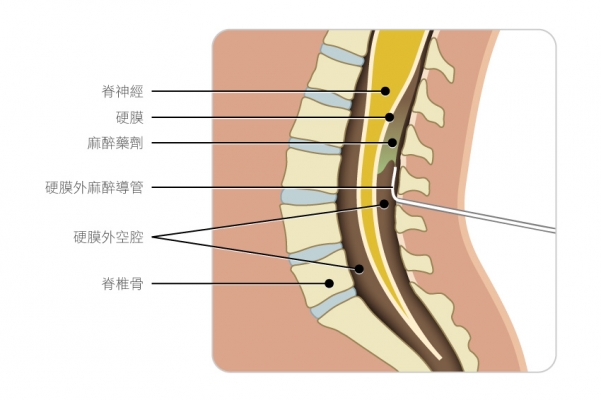
Schematics of epidural anesthesia
Intimate breast massage and aftercare
Self-care after breast augmentation surgery is compulsory for each patient and is our undeniable responsibility. Accurate and efficient breast massage can not only maintain sufficient space for newly placed breast implants but also facilitate movement between skin tissues and breast implants needed to keep the breasts soft and natural. Considering the significance of augmented breast massage, we offer regular postoperative breast massage and self-care courses to every patient free of charge. The professional team instructed and validated by Dr. Chuang will help you take good care of your breasts after surgery. Nurses experienced in breast augmentation surgeries will teach patients the correct self-massage methods at home and assist patients during the adaptation period. Generally, after approximately 3–6 months of daily regular breast massage, surgical results will become stable, and the time and frequency of massage can be gradually decreased until the end of the entire course.
Patients undergoing silicone breast implants are recommended by the Taiwanese government to undergo breast MRI once every 2–3 years to confirm the safety of breast implants. At present, Wish clinic has formed a close association with the local Aurora Asia Breast Health Center, which is dedicated to breast augmentation MRI. We can arrange examination visits or interpret reports on its behalf to offer patients one-stop health services. In addition, for patients unable to go to a hospital for examination, we also provide breast ultrasound screening once a year, with implant leakage diagnosis rates of up to 85%, so that patients can enjoy the basic health guarantee without any cost.
Aurora Asia Breast Health CenterGO
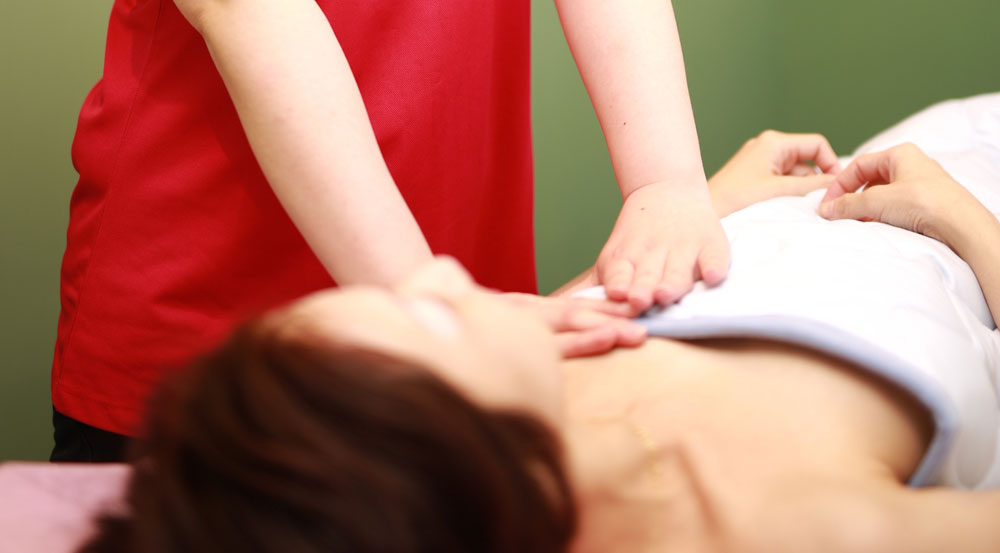
Proper breast massage is the key procedure to ensure successful of breast augmentation.




